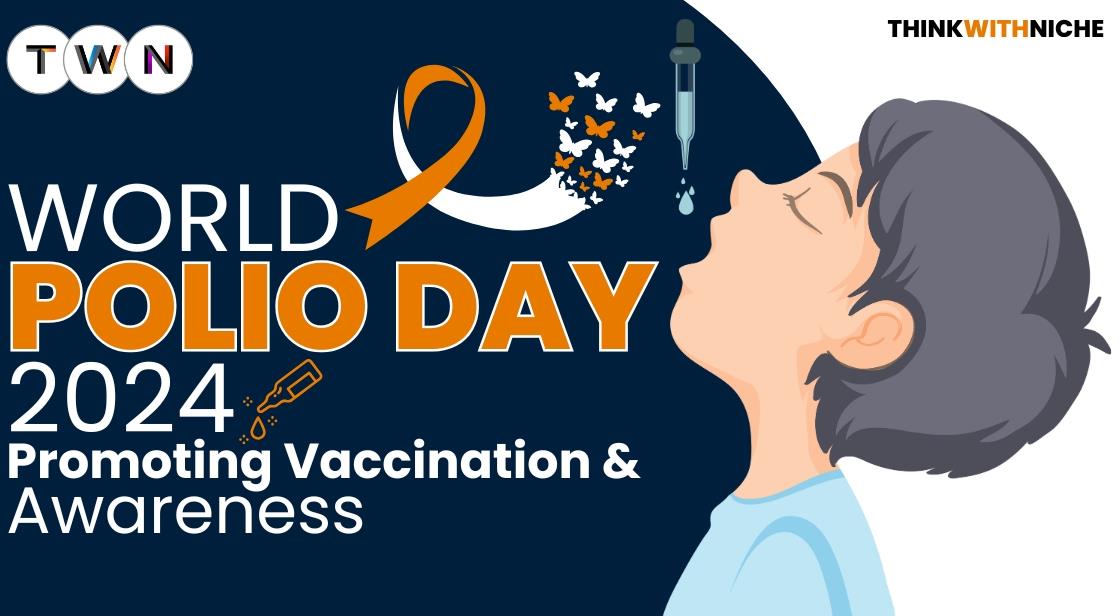World Polio Day 2024 Promoting Vaccination and Awareness

Blog Post
world Polio Day, observed annually on October 24, serves as a critical reminder of our ongoing battle against polio, a highly infectious disease that has historically devastated communities around the globe.
Established by Rotary International to commemorate the birth of Jonas Salk, the pioneer of the first successful polio vaccine, this day not only celebrates significant milestones in the fight against the disease but also highlights the urgent need for continued global vigilance and action.
While remarkable progress has been made in reducing polio cases by over 99%, with the disease now endemic in only a few regions, the threat of resurgence remains ever-present. This year, as we observe World Polio Day 2024, we unite to strengthen global immunization efforts, raise awareness, and mobilize resources to ensure that every child is protected from the crippling effects of polio.
Join us as we delve into the significance of world Polio Day, the global efforts to eradicate polio, and the crucial role vaccination plays in safeguarding future generations.
#WorldPolioDay #EndPolioNow #PolioEradication #VaccinesWork #EndPolio #GlobalHealth
#StopPolio #WHO #UNICEF #PolioFreeWorld #ZeroPolio #FightPolio #RotaryEndPolio
#Immunization #PolioAwareness #HealthForAll #TogetherAgainstPolio
World Polio Day 2024 Strengthening Global Immunization
World Polio Day, observed annually on October 24, is a global health event dedicated to raising awareness about polio, a crippling and potentially deadly infectious disease. It was established by Rotary International to commemorate the birth of Jonas Salk, the scientist who led the first successful polio vaccine development. This day is not only a reminder of the progress made in eradicating polio but also highlights the work that still needs to be done.
Significance of World Polio Day
The importance of World Polio Day lies in its role as a platform to educate the public, advocate for global vaccination, and mobilize resources to combat polio. It serves as a reminder that although significant progress has been made in reducing polio cases by 99%, the disease has not been completely eradicated. The last few countries where polio is still endemic, such as Pakistan and Afghanistan, face unique challenges, and without continued global support, the disease could resurface.
Global Efforts to Eradicate Polio
For decades, organizations like WHO, UNICEF, Rotary International, and the Global Polio Eradication Initiative (GPEI) have worked tirelessly to eliminate polio worldwide. Vaccination campaigns have been the cornerstone of these efforts, reaching millions of children even in the most remote areas. The combined efforts of healthcare workers, volunteers, and governments have brought the world closer to a polio-free future.
The History and Significance of World Polio Day
World Polio Day is observed annually on October 24, a day dedicated to raising awareness about the fight to eradicate polio and celebrating the progress made globally. The day was established by Rotary International to commemorate the birth of Jonas Salk, the medical researcher who developed the first safe and effective polio vaccine. World Polio Day is not just a reminder of the past battles against polio, but also a call to action to continue efforts toward complete eradication.
Origins of World Polio Day by Rotary International
Rotary International, one of the largest humanitarian organizations, has played a crucial role in the global fight against polio. It launched World Polio Day to keep the world focused on this critical health issue. Rotary’s initiative to eradicate polio began in 1985 through its PolioPlus program, which was the first and largest internationally coordinated public health initiative aimed at eliminating polio worldwide. The establishment of World Polio Day aims to highlight the organization’s ongoing contributions and encourage global citizens to participate in the eradication efforts.
Importance of Raising Awareness About Polio
Although polio cases have decreased by more than 99% since the late 1980s, continued awareness and vaccination efforts remain essential to prevent a resurgence. World Polio Day serves as an important platform to educate the public, emphasize the value of vaccines, and encourage funding for eradication programs. Raising awareness ensures that complacency does not take hold, and that even the last remaining regions of the world can be rid of the poliovirus.
Jonas Salk and the First Polio Vaccine
The development of the first polio vaccine by Jonas Salk in 1955 was a monumental step in the battle against the disease. Salk’s inactivated polio vaccine (IPV) has saved millions of lives, drastically reducing the prevalence of polio worldwide. His work laid the foundation for modern vaccination programs, transforming public health and bringing the world closer to eliminating the disease entirely.
Also Read: Global Impact of World Population Day 2024
What is Polio?
Polio, or poliomyelitis, is a highly infectious viral disease caused by the poliovirus. The virus mainly affects children under the age of five, attacking the nervous system and, in severe cases, leading to paralysis or death. Polio spreads through person-to-person contact, typically via contaminated water or food, and multiplies in the intestine.
Causes and Transmission of Polio
Polio is caused by the poliovirus, which enters the body through the mouth, usually from hands contaminated with the stool of an infected person. The virus then invades the nervous system and can cause paralysis in just a few hours. Poor hygiene and sanitation increase the risk of transmission, especially in areas where access to clean water is limited.
Symptoms of Polio
Most people infected with the poliovirus do not show any symptoms. However, some may experience flu-like symptoms such as fever, sore throat, headache, fatigue, and muscle stiffness. In severe cases, the virus can cause paralysis, typically affecting the legs. In rare instances, polio can affect respiratory muscles, leading to difficulty breathing and death.
Types of Polio
-
Wild Poliovirus (WPV): The naturally occurring form of the virus, responsible for causing outbreaks before the widespread use of vaccines.
-
Vaccine-Derived Poliovirus (VDPV): A rare form of the virus that can emerge in under-immunized populations from the live, weakened virus used in the oral polio vaccine (OPV). It behaves similarly to WPV in its ability to spread and cause illness.
Effects of Polio
Polio can have devastating effects, particularly on children. While most recover fully, others may suffer from permanent paralysis, affecting mobility and quality of life. The impact is most severe in children under five, who are at the highest risk. Polio can also cause death if the virus affects the muscles that help with breathing.
Why Eradication is Important
Eradicating polio is crucial because the disease has no cure, but it is preventable with vaccination. Global efforts to eliminate polio protect future generations from this disabling and life-threatening disease.
Progress in Polio Eradication
The fight against polio has been a long and challenging journey, but global efforts have resulted in significant milestones toward the eradication of this crippling disease. Here is a summary of the progress made and the ongoing challenges.
Global Milestones in Polio Eradication
Since the launch of the Global Polio Eradication Initiative (GPEI) in 1988, cases of polio have decreased by more than 99%. The world saw over 350,000 cases of polio each year before the campaign, but by 2023, only a few cases of wild poliovirus were reported globally. Polio has been successfully eradicated from all but two countries, marking one of the greatest public health achievements.
Polio Eradication in Most Countries
Today, most of the world is polio-free. Countries like the United States, Europe, and many parts of Asia and Africa have successfully eliminated wild poliovirus transmission. This has been possible through coordinated vaccination campaigns, improved healthcare systems, and public health initiatives. As of 2020, the African continent was declared free of wild poliovirus, a monumental victory in the global fight against the disease.
Contributions of Key Organizations
The eradication efforts have been spearheaded by key organizations, including the World Health Organization (WHO), UNICEF, Rotary International, and the Global Polio Eradication Initiative (GPEI). These organizations have worked together to vaccinate billions of children, deliver essential healthcare services, and raise awareness about polio. Rotary International alone has contributed over $2 billion to the cause, mobilizing communities worldwide.
Challenges in Polio-Endemic Areas
Despite tremendous progress, polio remains endemic in two countries: Afghanistan and Pakistan. In these regions, ongoing challenges such as conflict, political instability, vaccine misinformation, and inaccessibility have hindered complete eradication. Additionally, there are occasional outbreaks of vaccine-derived poliovirus in areas with low vaccination coverage, requiring continued vigilance and targeted immunization efforts.
While the fight against polio is nearing its end, sustained global cooperation and dedication are needed to overcome the final barriers.
The Importance of Vaccination in Polio Eradication
Vaccination: The Most Effective Way to Prevent Polio
Vaccination is widely recognized as the most powerful tool in the fight against polio. By immunizing populations, especially children, vaccines provide protection from the poliovirus, which can lead to paralysis and even death. Through widespread vaccination, the transmission of the virus can be interrupted, ultimately leading to its eradication. Vaccination helps to build immunity in individuals, reducing the spread of the virus within communities and protecting those who cannot be vaccinated due to medical reasons.
How Polio Vaccines Work: Oral Polio Vaccine (OPV) and Inactivated Polio Vaccine (IPV)
There are two primary types of polio vaccines: the Oral Polio Vaccine (OPV) and the Inactivated Polio Vaccine (IPV).
-
OPV is administered orally and contains a weakened form of the poliovirus. This vaccine stimulates immunity in the intestines, where the virus multiplies, thus reducing its ability to spread. OPV is highly effective in preventing person-to-person transmission of the virus and is often used in mass immunization campaigns due to its ease of administration.
-
IPV, on the other hand, is administered via injection and contains an inactivated (killed) poliovirus. IPV is highly effective in inducing immunity in the bloodstream and is used to protect individuals from the virus. It does not contribute to stopping the spread of the virus in the community as effectively as OPV but plays a crucial role in individual protection, particularly in polio-free countries.
Global Success of Vaccination Campaigns
Vaccination campaigns have dramatically reduced polio cases worldwide. The Global Polio Eradication Initiative (GPEI) has been pivotal in reducing polio cases by over 99% since its launch in 1988. Countries like India, once a hotspot for polio, were declared polio-free in 2014 due to widespread vaccination efforts. Today, polio remains endemic in only a few countries, and with continued global vaccination campaigns, the world is closer than ever to eradicating this devastating disease.
Promoting Awareness: Why It’s Still Necessary
Risks of Complacency
-
Resurgence of Polio: If vaccination rates drop, polio can make a comeback, especially in regions with low immunity. Complacency can undo decades of hard work and investment.
-
Global Travel: In today's interconnected world, polio can quickly spread across borders. High immunization coverage is necessary to prevent international outbreaks.
Impact of Misinformation
-
Vaccine Hesitancy: Misinformation about vaccines can lead to hesitancy, reducing vaccination coverage and increasing the risk of polio outbreaks.
-
Distrust in Health Systems: False information can erode trust in health professionals and public health systems, making it harder to combat diseases.
Role of Education, Outreach, and Community Participation
-
Education: Informing communities about the importance of vaccines through schools, local leaders, and healthcare workers can counteract misinformation. Clear, science-based information helps build trust and understanding.
-
Outreach: Effective outreach programs ensure that vaccination campaigns reach even the most remote areas. Mobile clinics, community health workers, and local campaigns are vital in maintaining high vaccination rates.
-
Community Participation: Engaging local communities in the planning and implementation of vaccination campaigns fosters a sense of ownership and cooperation. Community leaders, religious figures, and influential locals can play a pivotal role in advocating for vaccination.
Why Awareness Is Still Necessary
-
Sustained Efforts: Awareness campaigns remind people of the importance of continuing vaccination efforts until polio is completely eradicated.
-
Combatting Myths: Public awareness initiatives help dispel myths and misinformation about vaccines, ensuring people understand the benefits and safety of immunization.
-
Funding and Support: Ongoing awareness efforts help maintain public and governmental support for polio eradication programs, ensuring that they receive the necessary funding and resources.
In short, continued vigilance, education, and community involvement are essential to achieving and maintaining a polio-free world. It's about keeping the momentum and ensuring every child is protected.
The Role of Global and Local Initiatives in 2024
Key Events and Campaigns
Social Media Campaigns: Organizations like Rotary International and UNICEF are leveraging social media platforms to spread awareness about polio eradication efforts. They are sharing stories, statistics, and calls to action to engage the public and encourage donations.
Local Vaccination Drives: In regions where polio is still endemic, local health authorities and NGOs are organizing vaccination drives to ensure every child receives the polio vaccine. For example, in Gaza, two phases of outbreak response campaigns were conducted, reaching over 550,000 children.
Public Health Webinars: Various health organizations are hosting webinars to discuss the progress and challenges in the fight against polio. These webinars feature experts, healthcare professionals, and community leaders who share insights and strategies for eradication.
Fundraising Events: Rotary clubs and other non-profit organizations are hosting fundraising events such as concerts, charity runs, and auctions to raise funds for polio eradication programs.
Role of Governments, Healthcare Professionals, and Non-Profit Organizations
Governments: Governments play a crucial role in supporting vaccination efforts by providing funding, policy support, and logistical assistance. They also work to ensure high vaccination coverage and strengthen surveillance systems to detect and respond to polio outbreaks.
Healthcare Professionals: Doctors, nurses, and other healthcare workers are on the front lines, administering vaccines and educating communities about the importance of immunization. Their expertise and dedication are vital in reaching every child with the polio vaccine.
Non-Profit Organizations: Organizations like Rotary International, UNICEF, and the World Health Organization (WHO) are instrumental in coordinating global efforts, raising awareness, and mobilizing resources. They work closely with governments and local communities to ensure the success of vaccination campaigns.
World Polio Day 2024 is not just about celebrating achievements but also about mobilizing people and resources to finish the job of eradicating polio once and for all. It's a reminder that with continued commitment and collaboration, a polio-free world is within reach.
Success Stories: Nations that Eliminated Polio
Here are some success stories of nations that have eliminated polio and the impact it has had on public health:
1. India
India was once considered the epicenter of polio. However, through a massive vaccination campaign, the country registered its last case of wild poliovirus in January 2011. The South-East Asia region was certified polio-free in March 2014. The infrastructure and knowledge gained from the polio eradication efforts have been leveraged to improve routine immunization and tackle other public health issues.
2. Nigeria
Nigeria faced significant challenges due to political instability and resistance to vaccination. However, persistent efforts by the government, WHO, UNICEF, and other partners led to the last case of wild poliovirus being reported in 2016. Nigeria's success has been a major milestone in the global fight against polio.
3. Ethiopia
Ethiopia was declared polio-free in 2001. The success of the vaccination program has been attributed to strong government commitment, community engagement, and effective surveillance systems. The infrastructure built for polio eradication has been used to strengthen other health programs, such as measles and rubella vaccination campaigns.
4. United States
The United States eliminated polio in 1979. The success of the vaccination program has been a model for other countries. The infrastructure and expertise developed during the polio eradication efforts have been used to address other public health challenges, such as the introduction of new vaccines and improving immunization coverage.
Impact on Public Health
The global effort to eradicate polio has had a profound impact on public health. It has led to the development of robust immunization systems, improved surveillance, and the ability to respond to other infectious diseases. The same healthcare workers who administer polio vaccines have also delivered billions of doses of vitamin A, which decreases the risk of disease and death among children.
These success stories highlight the importance of vaccination programs and the positive impact they can have on public health. The fight against polio has not only saved countless lives but also strengthened health systems worldwide.
You May Like
EDITOR’S CHOICE












